Potential Causal Association between Elevated Gamma-Glutamyl Transferase Level and Stroke: A Two-Sample Mendelian Randomization Study
Abstract
:1. Introduction
2. Materials and Methods
2.1. Study Design
2.2. Data Sources
2.3. Selection of the Genetic Instrumental Variables
2.4. Mendelian Randomization
3. Results
3.1. Heterogeneity and Horizontal Pleiotropy of the Instrumental Variables
3.2. Mendelian Randomization for the Causal Association between Gamma-Glutamyl Transferase and Stroke
3.3. Mendelian Randomization for the Causal Association between Gamma-Glutamyl Transferase and Stroke Subtype
4. Discussion
5. Conclusions
Supplementary Materials
Author Contributions
Funding
Institutional Review Board Statement
Informed Consent Statement
Data Availability Statement
Acknowledgments
Conflicts of Interest
References
- Campbell, B.C.V.; Khatri, P. Stroke. Lancet 2020, 396, 129–142. [Google Scholar] [CrossRef]
- Benjamin, E.J.; Muntner, P.; Alonso, A.; Bittencourt, M.S.; Callaway, C.W.; Carson, A.P.; Chamberlain, A.M.; Chang, A.R.; Cheng, S.; Das, S.R.; et al. Heart Disease and Stroke Statistics-2019 Update: A Report from the American Heart Association. Circulation 2019, 139, e56–e528. [Google Scholar] [CrossRef]
- GBD 2016 Lifetime Risk of Stroke Collaborators; Feigin, V.L.; Nguyen, G.; Cercy, K.; Johnson, C.O.; Alam, T.; Parmar, P.G.; Abajobir, A.A.; Abate, K.H.; Abd-Allah, F.; et al. Global, Regional, and Country-Specific Lifetime Risks of Stroke, 1990 and 2016. N. Engl. J. Med. 2018, 379, 2429–2437. [Google Scholar] [CrossRef]
- Hankey, G.J. Stroke. Lancet 2017, 389, 641–654. [Google Scholar] [CrossRef] [PubMed]
- Frerich, S.; Malik, R.; Georgakis, M.K.; Sinner, M.F.; Kittner, S.J.; Mitchell, B.D.; Dichgans, M. Cardiac Risk Factors for Stroke: A Comprehensive Mendelian Randomization Study. Stroke 2022, 53, e130–e135. [Google Scholar] [CrossRef] [PubMed]
- Wu, M.; Zha, M.; Lv, Q.; Xie, Y.; Yuan, K.; Zhang, X.; Liu, X. Non-alcoholic fatty liver disease and stroke: A Mendelian randomization study. Eur. J. Neurol. 2022, 29, 1534–1537. [Google Scholar] [CrossRef] [PubMed]
- Rajendran, P.; Rengarajan, T.; Thangavel, J.; Nishigaki, Y.; Sakthisekaran, D.; Sethi, G.; Nishigaki, I. The vascular endothelium and human diseases. Int. J. Biol. Sci. 2013, 9, 1057–1069. [Google Scholar] [CrossRef]
- Foyer, C.H.; Noctor, G. Redox homeostasis and antioxidant signaling: A metabolic interface between stress perception and physiological responses. Plant Cell 2005, 17, 1866–1875. [Google Scholar] [CrossRef] [PubMed]
- Kunutsor, S.K. Gamma-glutamyltransferase-friend or foe within? Liver Int. 2016, 36, 1723–1734. [Google Scholar] [CrossRef]
- Jeon, J.; Kim, D.H.; Kim, W.; Choi, D.W.; Jung, K.J.; Jang, S.I. Dose-response relationship between gamma-glutamyltransferase and the risk of atherosclerotic cardiovascular diseases in Korean adults. Atherosclerosis 2020, 292, 152–159. [Google Scholar] [CrossRef]
- Zhang, X.W.; Li, M.; Hou, W.S.; Li, K.; Zhou, J.R.; Tang, Z.Y. Association between Gamma-Glutamyltransferase Level and Risk of Stroke: A Systematic Review and Meta-analysis of Prospective Studies. J. Stroke Cerebrovasc. Dis. 2015, 24, 2816–2823. [Google Scholar] [CrossRef]
- Kalirawna, T.R.; Rohilla, J.; Bairwa, S.S.; Gothwal, S.K.; Tak, P.; Jain, R. Increased concentration of serum gamma-glutamyl transferase in ischemic stroke patients. Brain Circ. 2021, 7, 71–76. [Google Scholar] [CrossRef]
- Li, S.; Wang, A.; Tian, X.; Zuo, Y.; Meng, X.; Zhang, Y. Elevated gamma-glutamyl transferase levels are associated with stroke recurrence after acute ischemic stroke or transient ischemic attack. CNS Neurosci. Ther. 2022, 28, 1637–1647. [Google Scholar] [CrossRef] [PubMed]
- Tu, W.J.; Liu, Q.; Cao, J.L.; Zhao, S.J.; Zeng, X.W.; Deng, A.J. gamma-Glutamyl Transferase as a Risk Factor for All-Cause or Cardiovascular Disease Mortality among 5912 Ischemic Stroke. Stroke 2017, 48, 2888–2891. [Google Scholar] [CrossRef] [PubMed]
- Emdin, M.; Passino, C.; Donato, L.; Paolicchi, A.; Pompella, A. Serum gamma-glutamyltransferase as a risk factor of ischemic stroke might be independent of alcohol consumption. Stroke 2002, 33, 1163–1164. [Google Scholar] [CrossRef] [PubMed]
- Weikert, C.; Drogan, D.; di Giuseppe, R.; Fritsche, A.; Buijsse, B.; Nothlings, U.; Willich, S.N.; Berger, K.; Boeing, H. Liver enzymes and stroke risk in middle-aged German adults. Atherosclerosis 2013, 228, 508–514. [Google Scholar] [CrossRef]
- Burgess, S.; Thompson, S.G. Multivariable Mendelian randomization: The use of pleiotropic genetic variants to estimate causal effects. Am. J. Epidemiol. 2015, 181, 251–260. [Google Scholar] [CrossRef]
- Burgess, S.; Thompson, S.G. Interpreting findings from Mendelian randomization using the MR-Egger method. Eur. J. Epidemiol. 2017, 32, 377–389. [Google Scholar] [CrossRef]
- Li, Q.; Yan, S.; Li, Y.; Kang, H.; Zhu, H.; Lv, C. Mendelian Randomization Study of Heart Failure and Stroke Subtypes. Front. Cardiovasc. Med. 2022, 9, 844733. [Google Scholar] [CrossRef]
- Larsson, S.C.; Burgess, S.; Michaelsson, K. Smoking and stroke: A mendelian randomization study. Ann. Neurol. 2019, 86, 468–471. [Google Scholar] [CrossRef]
- Harshfield, E.L.; Georgakis, M.K.; Malik, R.; Dichgans, M.; Markus, H.S. Modifiable Lifestyle Factors and Risk of Stroke: A Mendelian Randomization Analysis. Stroke 2021, 52, 931–936. [Google Scholar] [CrossRef]
- Chen, L.; Peters, J.E.; Prins, B.; Persyn, E.; Traylor, M.; Surendran, P.; Karthikeyan, S.; Yonova-Doing, E.; Di Angelantonio, E.; Roberts, D.J.; et al. Systematic Mendelian randomization using the human plasma proteome to discover potential therapeutic targets for stroke. Nat. Commun. 2022, 13, 6143. [Google Scholar] [CrossRef] [PubMed]
- Choi, Y.; Lee, S.J.; Spiller, W.; Jung, K.J.; Lee, J.Y.; Kimm, H.; Back, J.H.; Lee, S.; Jee, S.H. Causal Associations Between Serum Bilirubin Levels and Decreased Stroke Risk: A Two-Sample Mendelian Randomization Study. Arterioscler. Thromb. Vasc. Biol. 2020, 40, 437–445. [Google Scholar] [CrossRef]
- Liangpunsakul, S.; Qi, R.; Crabb, D.W.; Witzmann, F. Relationship between alcohol drinking and aspartate aminotransferase:alanine aminotransferase (AST:ALT) ratio, mean corpuscular volume (MCV), gamma-glutamyl transpeptidase (GGT), and apolipoprotein A1 and B in the U.S. population. J. Stud. Alcohol. Drugs 2010, 71, 249–252. [Google Scholar] [CrossRef] [PubMed]
- Yang, W.; Kang, D.W.; Lee, S.H. Effects of Gamma-Glutamyl Transferase on Stroke Occurrence Mediated by Atrial Fibrillation. J. Clin. Neurol. 2020, 16, 60–65. [Google Scholar] [CrossRef] [PubMed]
- Xing, Y.; Chen, J.; Liu, J.; Ma, H. Associations Between GGT/HDL and MAFLD: A Cross-Sectional Study. Diabetes Metab. Syndr. Obes. 2022, 15, 383–394. [Google Scholar] [CrossRef]
- Pazoki, R.; Vujkovic, M.; Elliott, J.; Evangelou, E.; Gill, D.; Ghanbari, M.; van der Most, P.J.; Pinto, R.C.; Wielscher, M.; Farlik, M.; et al. Genetic analysis in European ancestry individuals identifies 517 loci associated with liver enzymes. Nat. Commun. 2021, 12, 2579. [Google Scholar] [CrossRef] [PubMed]
- Mishra, A.; Malik, R.; Hachiya, T.; Jurgenson, T.; Namba, S.; Posner, D.C.; Kamanu, F.K.; Koido, M.; Le Grand, Q.; Shi, M.; et al. Stroke genetics informs drug discovery and risk prediction across ancestries. Nature 2022, 611, 115–123. [Google Scholar] [CrossRef]
- Jiang, L.; Zheng, Z.; Fang, H.; Yang, J. A generalized linear mixed model association tool for biobank-scale data. Nat. Genet. 2021, 53, 1616–1621. [Google Scholar] [CrossRef]
- Nielsen, J.B.; Thorolfsdottir, R.B.; Fritsche, L.G.; Zhou, W.; Skov, M.W.; Graham, S.E.; Herron, T.J.; McCarthy, S.; Schmidt, E.M.; Sveinbjornsson, G.; et al. Biobank-driven genomic discovery yields new insight into atrial fibrillation biology. Nat. Genet. 2018, 50, 1234–1239. [Google Scholar] [CrossRef] [PubMed]
- Loh, P.R.; Kichaev, G.; Gazal, S.; Schoech, A.P.; Price, A.L. Mixed-model association for biobank-scale datasets. Nat. Genet. 2018, 50, 906–908. [Google Scholar] [CrossRef]
- Neuman, M.G.; Malnick, S.; Chertin, L. Gamma glutamyl transferase—An underestimated marker for cardiovascular disease and the metabolic syndrome. J. Pharm. Pharm. Sci. 2020, 23, 65–74. [Google Scholar] [CrossRef] [PubMed]
- Yang, W.; Kim, C.K.; Kim, D.Y.; Jeong, H.G.; Lee, S.H. Gamma-glutamyl transferase predicts future stroke: A Korean nationwide study. Ann. Neurol. 2018, 83, 375–386. [Google Scholar] [CrossRef]
- Burgess, S.; Butterworth, A.; Thompson, S.G. Mendelian randomization analysis with multiple genetic variants using summarized data. Genet. Epidemiol. 2013, 37, 658–665. [Google Scholar] [CrossRef] [PubMed]
- Bowden, J.; Del Greco, M.F.; Minelli, C.; Davey Smith, G.; Sheehan, N.; Thompson, J. A framework for the investigation of pleiotropy in two-sample summary data Mendelian randomization. Stat. Med. 2017, 36, 1783–1802. [Google Scholar] [CrossRef]
- Lee, Y.; Kim, Y.A.; Seo, J.H. Causal Association of Obesity and Dyslipidemia with Type 2 Diabetes: A Two-Sample Mendelian Randomization Study. Genes 2022, 13, 2407. [Google Scholar] [CrossRef]
- Bowden, J.; Davey Smith, G.; Haycock, P.C.; Burgess, S. Consistent Estimation in Mendelian Randomization with Some Invalid Instruments Using a Weighted Median Estimator. Genet. Epidemiol. 2016, 40, 304–314. [Google Scholar] [CrossRef]
- Bowden, J.; Davey Smith, G.; Burgess, S. Mendelian randomization with invalid instruments: Effect estimation and bias detection through Egger regression. Int. J. Epidemiol. 2015, 44, 512–525. [Google Scholar] [CrossRef]
- Bowden, J.; Del Greco, M.F.; Minelli, C.; Davey Smith, G.; Sheehan, N.A.; Thompson, J.R. Assessing the suitability of summary data for two-sample Mendelian randomization analyses using MR-Egger regression: The role of the I2 statistic. Int. J. Epidemiol. 2016, 45, 1961–1974. [Google Scholar] [CrossRef]
- Verbanck, M.; Chen, C.Y.; Neale, B.; Do, R. Publisher Correction: Detection of widespread horizontal pleiotropy in causal relationships inferred from Mendelian randomization between complex traits and diseases. Nat. Genet. 2018, 50, 1196. [Google Scholar] [CrossRef] [PubMed]
- Burgess, S.; Davey Smith, G.; Davies, N.M.; Dudbridge, F.; Gill, D.; Glymour, M.M.; Hartwig, F.P.; Holmes, M.V.; Minelli, C.; Relton, C.L.; et al. Guidelines for performing Mendelian randomization investigations. Wellcome Open Res. 2019, 4, 186. [Google Scholar] [CrossRef]
- Greco, M.F.; Minelli, C.; Sheehan, N.A.; Thompson, J.R. Detecting pleiotropy in Mendelian randomisation studies with summary data and a continuous outcome. Stat. Med. 2015, 34, 2926–2940. [Google Scholar] [CrossRef]
- Jin, H.; Lee, S.; Won, S. Causal Evaluation of Laboratory Markers in Type 2 Diabetes on Cancer and Vascular Diseases Using Various Mendelian Randomization Tools. Front. Genet. 2020, 11, 597420. [Google Scholar] [CrossRef] [PubMed]
- Whitfield, J.B. Gamma glutamyl transferase. Crit. Rev. Clin. Lab. Sci. 2001, 38, 263–355. [Google Scholar] [CrossRef]
- Wannamethee, S.G.; Lennon, L.; Shaper, A.G. The value of gamma-glutamyltransferase in cardiovascular risk prediction in men without diagnosed cardiovascular disease or diabetes. Atherosclerosis 2008, 201, 168–175. [Google Scholar] [CrossRef]
- Strasak, A.M.; Kelleher, C.C.; Klenk, J.; Brant, L.J.; Ruttmann, E.; Rapp, K.; Concin, H.; Diem, G.; Pfeiffer, K.P.; Ulmer, H.; et al. Longitudinal change in serum gamma-glutamyltransferase and cardiovascular disease mortality: A prospective population-based study in 76,113 Austrian adults. Arterioscler. Thromb. Vasc. Biol. 2008, 28, 1857–1865. [Google Scholar] [CrossRef]
- Shimizu, Y.; Imano, H.; Ohira, T.; Kitamura, A.; Kiyama, M.; Okada, T.; Sato, S.; Shimamoto, T.; Yamagishi, K.; Tanigawa, T.; et al. gamma-Glutamyltranspeptidase and incident stroke among Japanese men and women: The Circulatory Risk in Communities Study (CIRCS). Stroke 2010, 41, 385–388. [Google Scholar] [CrossRef] [PubMed]
- Tekin, G.; Tekin, Y.K.; Senarslan, D.A.; Gocmen, A.Y.; Senarslan, O.; Erbay, A.R. Serum gamma-glutamyltransferase activity in patients with nonvalvular atrial fibrillation. Angiology 2013, 64, 157–160. [Google Scholar] [CrossRef] [PubMed]
- Kunutsor, S.K.; Laukkanen, J.A.; Bluemke, D.A.; Butler, J.; Khan, H. Baseline and long-term gamma-glutamyltransferase, heart failure and cardiac arrhythmias in middle-aged Finnish men: Prospective study and pooled analysis of published evidence. Eur. J. Prev. Cardiol. 2016, 23, 1354–1362. [Google Scholar] [CrossRef]
- Guzik, A.; Bushnell, C. Stroke Epidemiology and Risk Factor Management. Continuum 2017, 23, 15–39. [Google Scholar] [CrossRef]
- Alonso, A.; Misialek, J.R.; Amiin, M.A.; Hoogeveen, R.C.; Chen, L.Y.; Agarwal, S.K.; Loehr, L.R.; Soliman, E.Z.; Selvin, E. Circulating levels of liver enzymes and incidence of atrial fibrillation: The Atherosclerosis Risk in Communities cohort. Heart 2014, 100, 1511–1516. [Google Scholar] [CrossRef] [PubMed]
- Arouca, A.; Moreno, L.A.; Gonzalez-Gil, E.M.; Marcos, A.; Widhalm, K.; Molnar, D.; Manios, Y.; Gottrand, F.; Kafatos, A.; Kersting, M.; et al. Diet as moderator in the association of adiposity with inflammatory biomarkers among adolescents in the HELENA study. Eur. J. Nutr. 2019, 58, 1947–1960. [Google Scholar] [CrossRef] [PubMed]
- Seo, J.H.; Lee, Y. Causal Association between Iritis or Uveitis and Glaucoma: A Two-Sample Mendelian Randomisation Study. Genes 2023, 14, 642. [Google Scholar] [CrossRef] [PubMed]
- Bowden, J.; Holmes, M.V. Meta-analysis and Mendelian randomization: A review. Res. Synth Methods 2019, 10, 486–496. [Google Scholar] [CrossRef] [PubMed]
- Birney, E. Mendelian Randomization. Cold Spring Harb. Perspect. Med. 2022, 12, a041302. [Google Scholar] [CrossRef]
- Fang, S.; Hu, X.; Wang, T.; Yang, Y.; Xu, R.; Zhang, X.; Luo, J.; Ma, Y.; Patel, A.B.; Dmytriw, A.A.; et al. Parkinson’s Disease and Ischemic Stroke: A Bidirectional Mendelian Randomization Study. Transl. Stroke Res. 2022, 13, 528–532. [Google Scholar] [CrossRef]
- Ma, C.; Wu, M.; Gao, J.; Liu, C.; Xie, Y.; Lv, Q.; Zhang, X. Periodontitis and stroke: A Mendelian randomization study. Brain Behav. 2023, 13, e2888. [Google Scholar] [CrossRef]
- Zheng, M.; Zheng, S. Endometriosis Increases the Risk of Stroke: A Mendelian Randomization Study. Stroke 2023, 54, e30–e33. [Google Scholar] [CrossRef]
- Borges, M.C.; Haycock, P.C.; Zheng, J.; Hemani, G.; Holmes, M.V.; Davey Smith, G.; Hingorani, A.D.; Lawlor, D.A. Role of circulating polyunsaturated fatty acids on cardiovascular diseases risk: Analysis using Mendelian randomization and fatty acid genetic association data from over 114,000 UK Biobank participants. BMC Med. 2022, 20, 210. [Google Scholar] [CrossRef]
- Parikh, N.S. Mendelian randomization elucidates links between nonalcoholic fatty liver disease and stroke. Eur. J. Neurol. 2022, 29, 1291–1292. [Google Scholar] [CrossRef]
- Peng, H.; Wang, S.; Wang, M.; Ye, Y.; Xue, E.; Chen, X.; Wang, X.; Fan, M.; Gao, W.; Qin, X.; et al. Nonalcoholic fatty liver disease and cardiovascular diseases: A Mendelian randomization study. Metabolism 2022, 133, 155220. [Google Scholar] [CrossRef] [PubMed]
- Au Yeung, S.L.; Borges, M.C.; Wong, T.H.T.; Lawlor, D.A.; Schooling, C.M. Evaluating the role of non-alcoholic fatty liver disease in cardiovascular diseases and type 2 diabetes: A Mendelian randomization study in Europeans and East Asians. Int. J. Epidemiol. 2023, 52, 921–931. [Google Scholar] [CrossRef]
- Niemela, O. Biomarkers in alcoholism. Clin. Chim. Acta 2007, 377, 39–49. [Google Scholar] [CrossRef] [PubMed]
- Harris, J.C.; Leggio, L.; Farokhnia, M. Blood Biomarkers of Alcohol Use: A Scoping Review. Curr. Addict. Rep. 2021, 8, 500–508. [Google Scholar] [CrossRef] [PubMed]
- Minelli, C.; Del Greco, M.F.; van der Plaat, D.A.; Bowden, J.; Sheehan, N.A.; Thompson, J. The use of two-sample methods for Mendelian randomization analyses on single large datasets. Int. J. Epidemiol. 2021, 50, 1651–1659. [Google Scholar] [CrossRef] [PubMed]
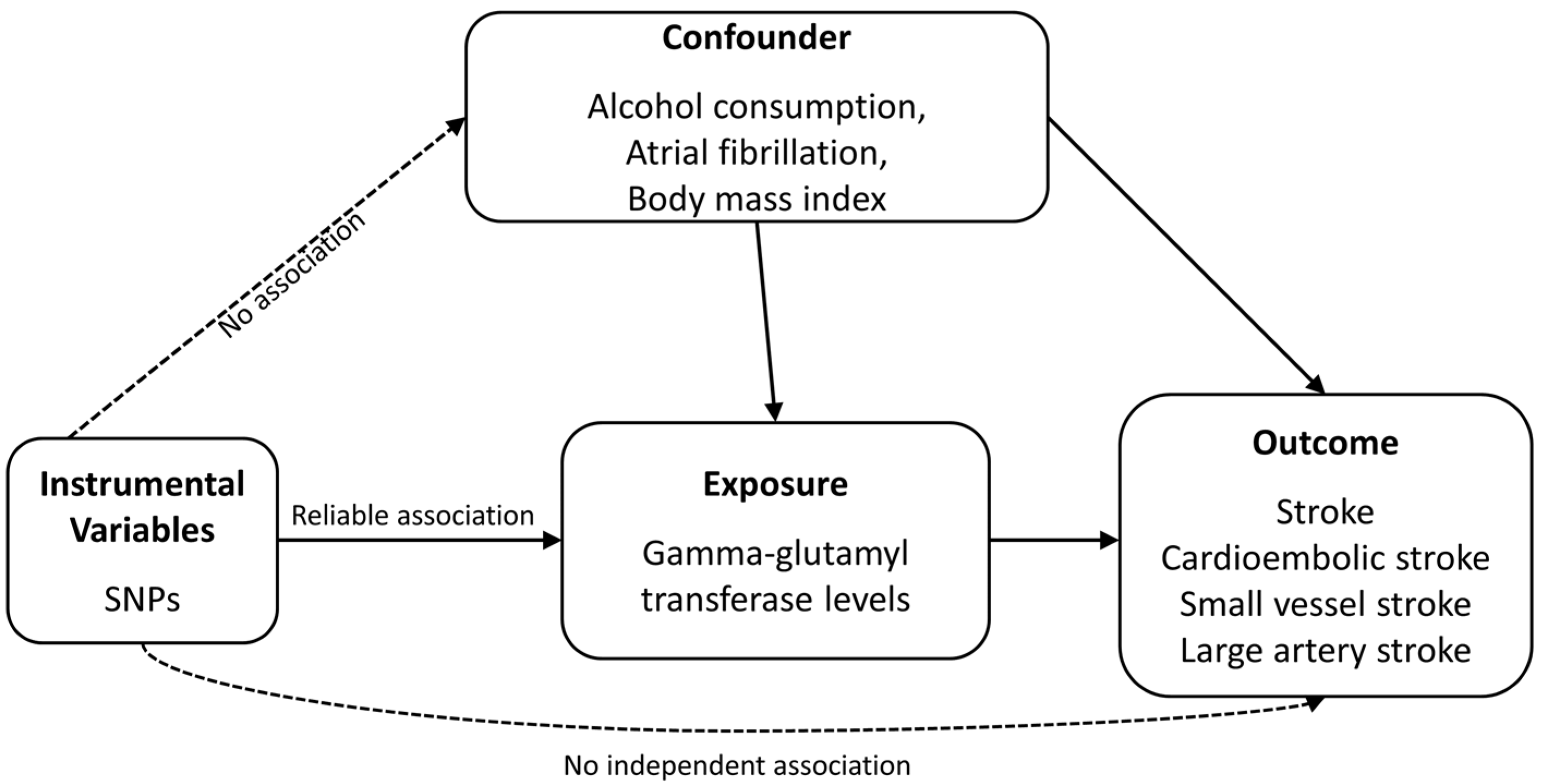
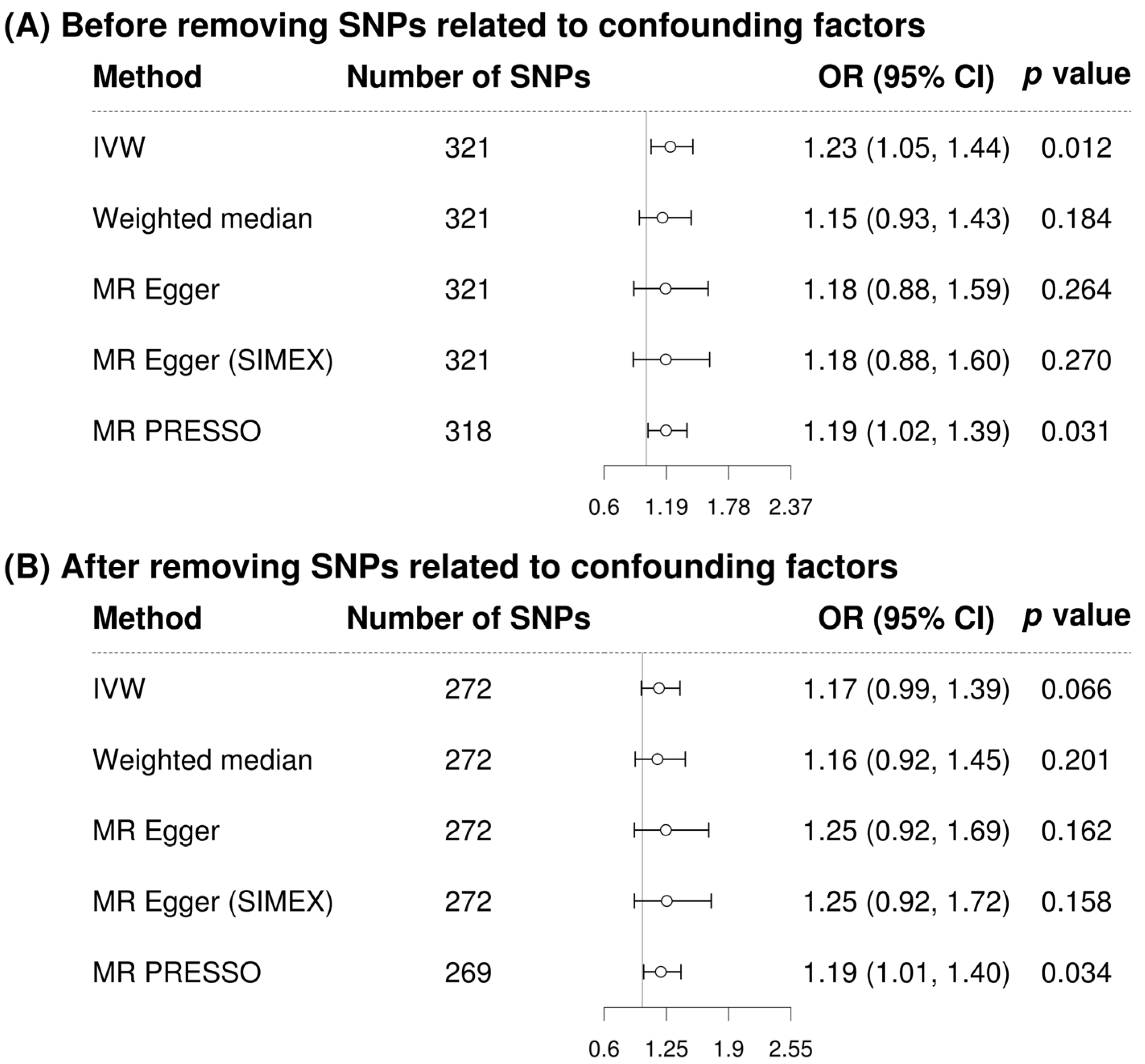
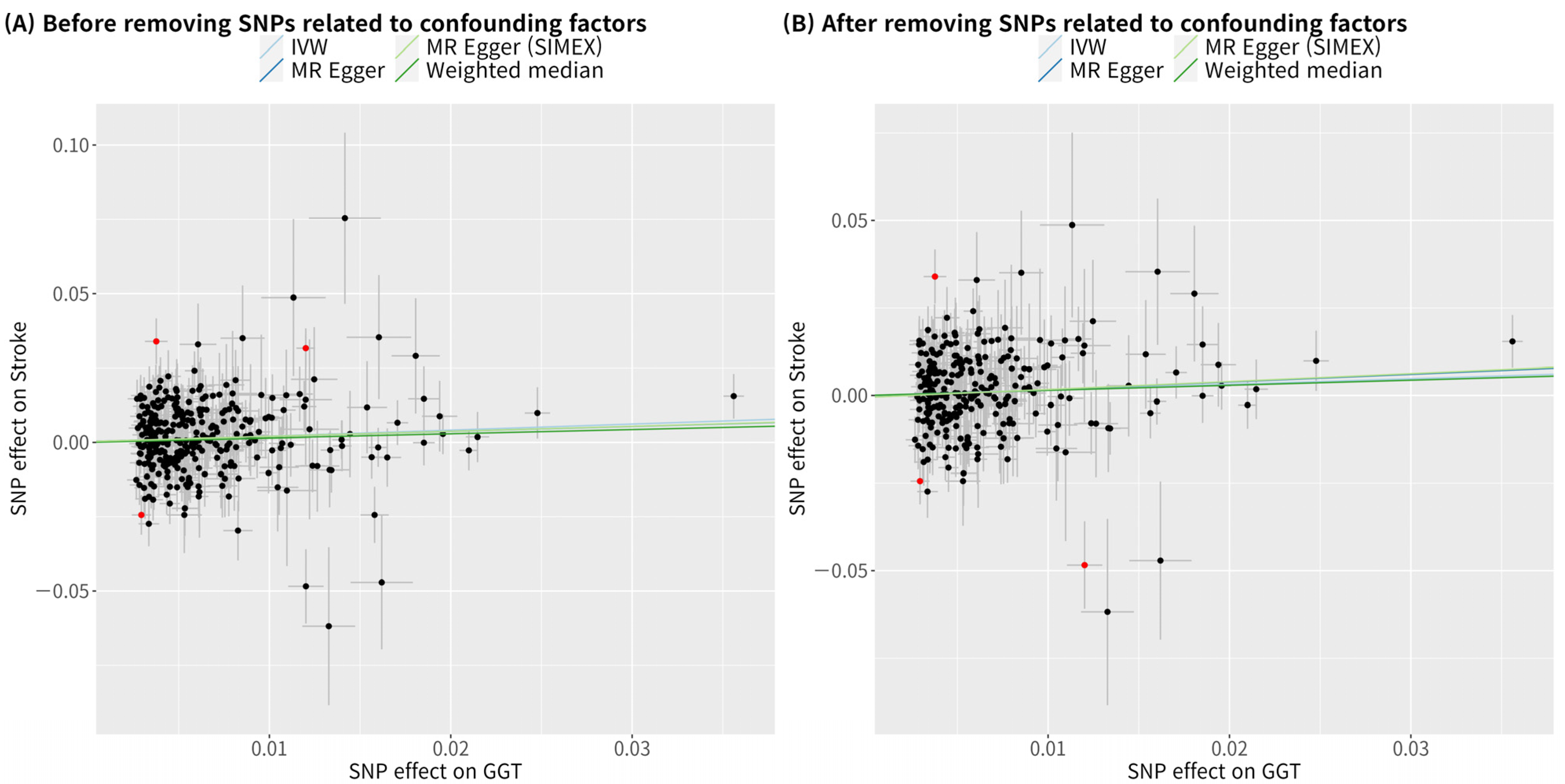
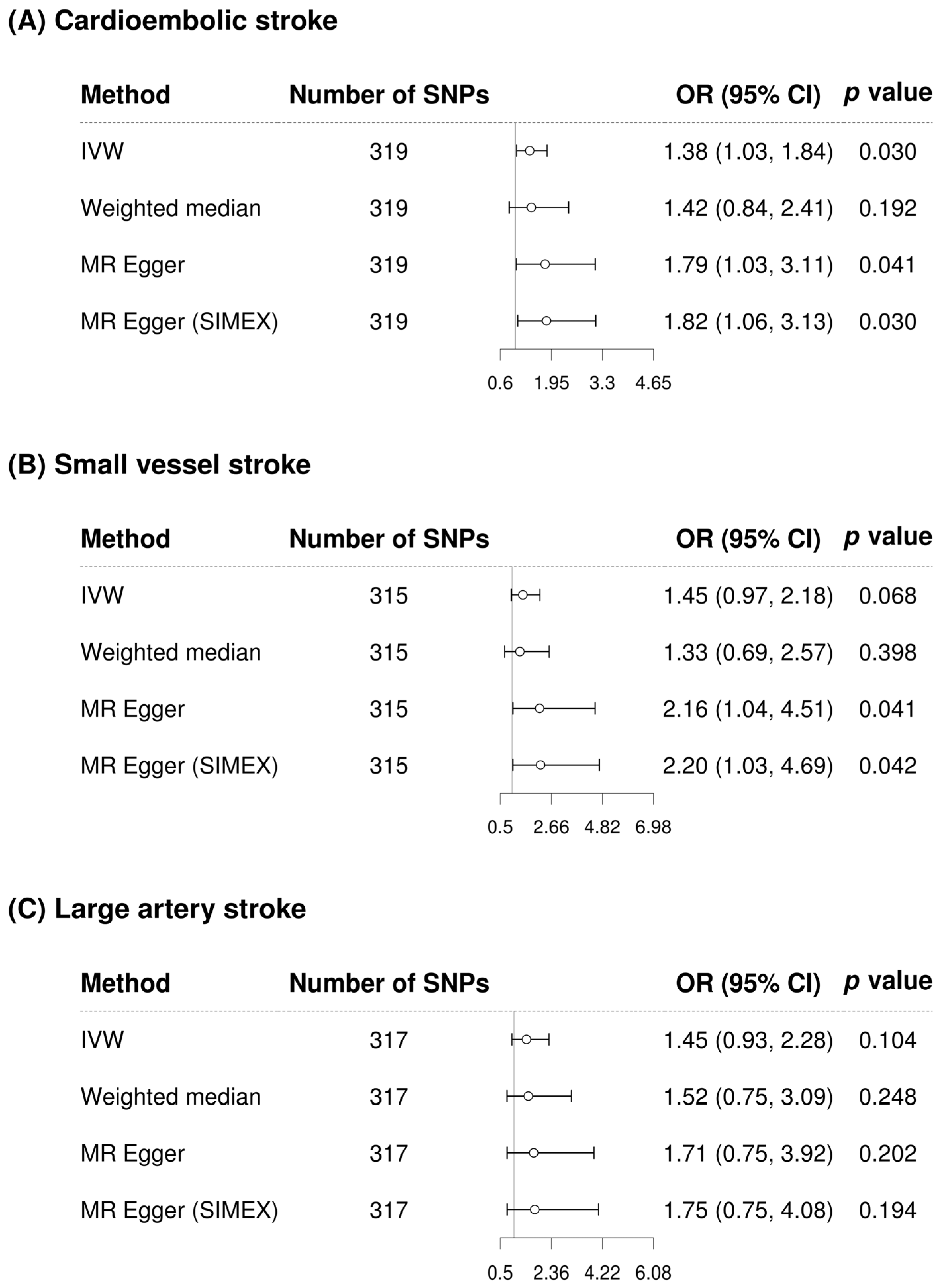
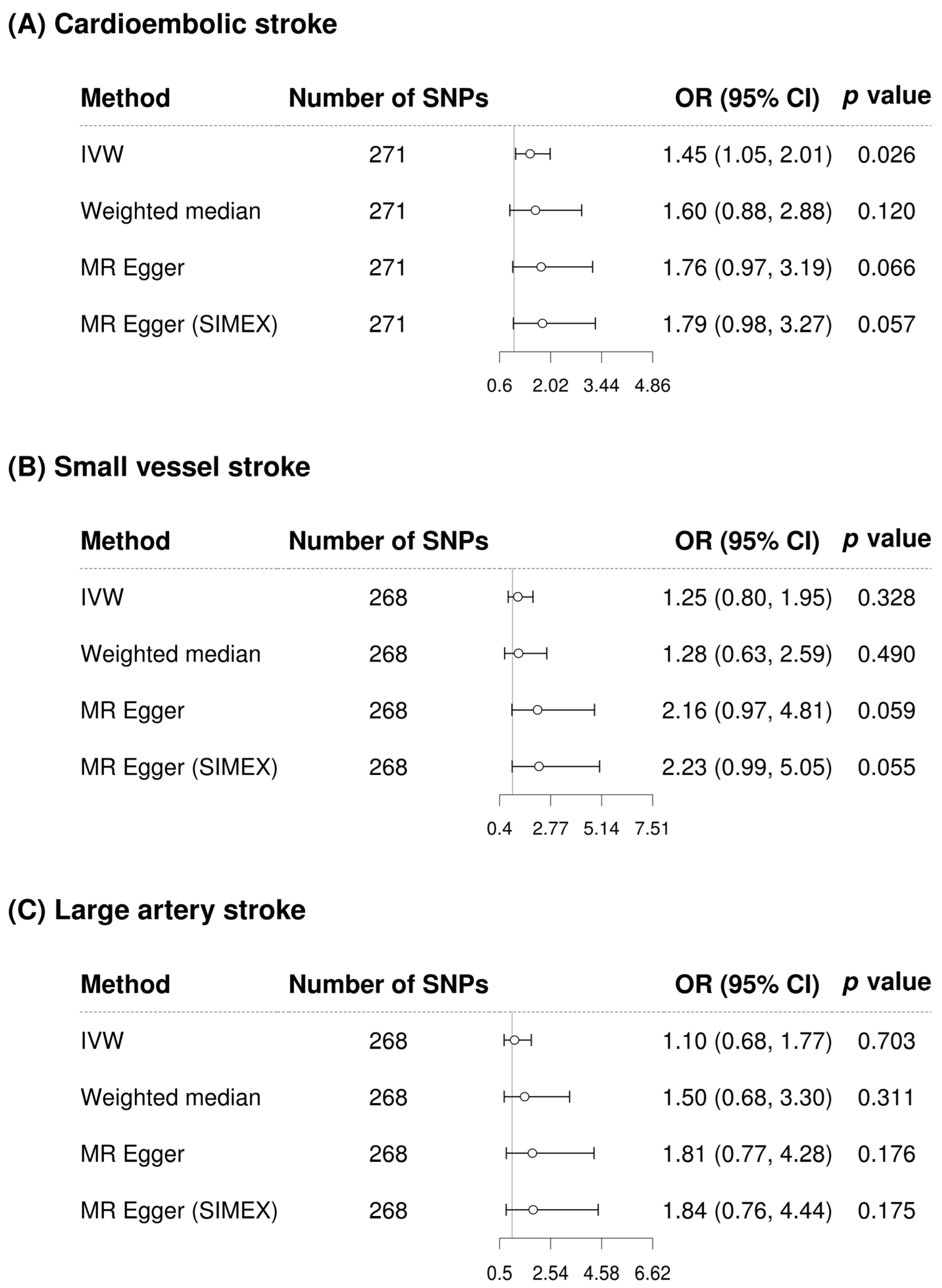

| Traits | Data Source | No. of Participants | Population | No. of Variants | Reference |
|---|---|---|---|---|---|
| Serum gamma-glutamyl transferase | UK Biobank (UKB) | 437,194 | European (U.K.) | 16,901,631 | [27] |
| Alcohol consumption | UKB | 64,001 (31,460 cases + 32,541 controls) | European (U.K.) | 11,831,323 | [29] |
| Atrial fibrillation | The Nord-Trøndelag HealthStudy (HUNT), deCODE, the Michigan Genomics Initiative (MGI), DiscovEHR, UKB, and the AFGen Consortium | 1,030,836 (60,620 cases + 970,216 controls) | European (U.S., Iceland, Norway, U.K.) | 34,740,186 | [30] |
| Body mass index | UKB | 532,396 | European (U.K.) | 12,007,571 | [31] |
| Stroke | The GIGASTROKE Consortium | 2,036,031 (136,047 cases + 1,899,984 controls) | European (Iceland, Spain, Canada, Sweden, Netherlands, U.S., Finland, Denmark, U.K., France, Austrailia, Germany, Estonia) | 7,511,476 | [28] |
| Cardioembolic stroke | 1,245,612 (10,804 cases + 1,234,808 controls) | 6,659,793 | |||
| Small vessel stroke | 1,241,619 (6811 cases + 1,234,808 controls) | 5,974,028 | |||
| Large artery stroke | 1,241,207 (6399 cases + 1,234,808 controls) | 5,784,788 |
| Outcome | Heterogeneity | Horizontal Pleiotropy | ||||||||
|---|---|---|---|---|---|---|---|---|---|---|
| Cochran’s Q Test from IVW | Rucker’s Q’ Test from MR-Egger | MR-PRESSO Global Test | MR-Egger | MR-Egger (SIMEX) | ||||||
| N | F | I2 (%) | p-Value | p-Value | p-Value | Intercept, β (SE) | p-Value | Intercept, β (SE) | p-Value | |
| Before removing SNPs related to confounding factors * | ||||||||||
| Stroke | 321 | 134.18 | 97.46 | <0.001 | <0.001 | <0.001 | 0.000 (0.001) | 0.764 | 0.000 (0.001) | 0.776 |
| Cardioembolic stroke | 319 | 134.11 | 97.48 | 0.894 | 0.896 | 0.902 | −0.002 (0.002) | 0.272 | −0.002 (0.002) | 0.230 |
| Small vessel stroke | 315 | 134.82 | 97.50 | 0.038 | 0.041 | 0.035 | −0.003 (0.003) | 0.208 | −0.003 (0.003) | 0.202 |
| Large artery stroke | 317 | 134.27 | 97.51 | 0.006 | 0.005 | 0.005 | −0.001 (0.003) | 0.639 | −0.002 (0.003) | 0.614 |
| After removing SNPs related to confounding factors * | ||||||||||
| Stroke | 272 | 131.77 | 97.48 | <0.001 | <0.001 | <0.001 | −0.001 (0.001) | 0.650 | −0.001 (0.001) | 0.627 |
| Cardioembolic stroke | 271 | 131.36 | 97.50 | 0.681 | 0.674 | 0.683 | −0.002 (0.002) | 0.449 | −0.002 (0.002) | 0.414 |
| Small vessel stroke | 268 | 132.07 | 97.51 | 0.036 | 0.042 | 0.038 | −0.005 (0.003) | 0.106 | −0.005 (0.003) | 0.099 |
| Large artery stroke | 268 | 131.77 | 97.55 | 0.063 | 0.069 | 0.069 | −0.004 (0.003) | 0.171 | −0.004 (0.003) | 0.168 |
| Stroke | Cardioembolic Stroke | Small Vessel Stroke | Large Artery Stroke | |||||||||
|---|---|---|---|---|---|---|---|---|---|---|---|---|
| MR Exposures | N | OR (95% CI) | p-Value | N | OR (95% CI) | p-Value | N | OR (95% CI) | p-Value | N | OR (95% CI) | p-Value |
| Serum gamma-glutamyl transferase | 409 | 1.30 (1.07, 1.60) | 0.010 | 397 | 1.15 (0.75, 1.77) | 0.531 | 384 | 1.79 (1.01, 3.16) | 0.046 | 384 | 1.94 (1.06, 3.56) | 0.032 |
| Alcohol consumption | 409 | 0.96 (0.90, 1.03) | 0.238 | 397 | 0.97 (0.84, 1.12) | 0.665 | 384 | 0.88 (0.73, 1.07) | 0.205 | 384 | 0.96 (0.78, 1.17) | 0.663 |
| Atrial fibrillation | 409 | 1.13 (1.09, 1.17) | <0.001 | 397 | 1.86 (1.73, 2.01) | <0.001 | 384 | 1.02 (0.93, 1.13) | 0.630 | 384 | 1.03 (0.92, 1.14) | 0.616 |
| Body mass index | 409 | 1.10 (1.02, 1.18) | 0.009 | 397 | 0.97 (0.83, 1.13) | 0.677 | 384 | 1.16 (0.95, 1.41) | 0.149 | 384 | 1.20 (0.97, 1.48) | 0.100 |
Disclaimer/Publisher’s Note: The statements, opinions and data contained in all publications are solely those of the individual author(s) and contributor(s) and not of MDPI and/or the editor(s). MDPI and/or the editor(s) disclaim responsibility for any injury to people or property resulting from any ideas, methods, instructions or products referred to in the content. |
© 2023 by the authors. Licensee MDPI, Basel, Switzerland. This article is an open access article distributed under the terms and conditions of the Creative Commons Attribution (CC BY) license (https://creativecommons.org/licenses/by/4.0/).
Share and Cite
Lee, Y.; Seo, J.H. Potential Causal Association between Elevated Gamma-Glutamyl Transferase Level and Stroke: A Two-Sample Mendelian Randomization Study. Biomolecules 2023, 13, 1592. https://doi.org/10.3390/biom13111592
Lee Y, Seo JH. Potential Causal Association between Elevated Gamma-Glutamyl Transferase Level and Stroke: A Two-Sample Mendelian Randomization Study. Biomolecules. 2023; 13(11):1592. https://doi.org/10.3390/biom13111592
Chicago/Turabian StyleLee, Young, and Je Hyun Seo. 2023. "Potential Causal Association between Elevated Gamma-Glutamyl Transferase Level and Stroke: A Two-Sample Mendelian Randomization Study" Biomolecules 13, no. 11: 1592. https://doi.org/10.3390/biom13111592
APA StyleLee, Y., & Seo, J. H. (2023). Potential Causal Association between Elevated Gamma-Glutamyl Transferase Level and Stroke: A Two-Sample Mendelian Randomization Study. Biomolecules, 13(11), 1592. https://doi.org/10.3390/biom13111592






